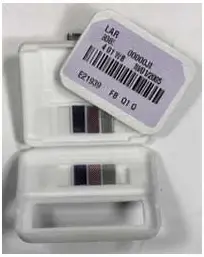TLD – Thermoluminescent Dosimeter
A thermoluminescent dosimeter, abbreviated as TLD, is a passive radiation dosimeter, that measures ionizing radiation exposure by measuring the intensity of visible light emitted from a sensitive crystal in the detector when the crystal is heated. The intensity of light emitted is measure by TLD reader and it is dependent upon the radiation exposure. Thermoluminescent dosimeters was invented in 1954 by Professor Farrington Daniels of the University of Wisconsin-Madison. TLD dosimeters are applicable to situations where real-time information is not needed, but precise accumulated dose monitoring records are desired for comparison to field measurements or for assessing the potential for long term health effects. In dosimetry, both the quartz fiber and film badge types are being superseded by TLDs and EPDs (Electronic Personal Dosimeter).
Advantages and Disadvantages of TLDs
Advantages of TLDs
- TLDs are able to measure a greater range of doses in comparison with film badges.
- Doses from TLDs may be easily obtained.
- TLDs can be read on site instead of being sent away for developing.
- TLDs are easily reusable.
Disadvantages of TLDs
- Each dose cannot be read out more than once.
- The readout process effectively “zeroes” the TLD.
Film Badge Dosimeter
Film badges, film badge dosimeters, are small portable devices for monitoring cumulative radiation dose due to ionizing radiation. Principle of operation is similar as for X-ray pictures. The badge consists of two parts: photographic film, and a holder. The film is contained inside a badge. The piece of photographic film that is the sensitive material and it must be removed monthly and developed. The more radiation exposure, the more blackening of the film. The blackening of the film is linear to the dose, and doses up to about 10 Gy can be measured.

Advantages and Disadvantages of Film Dosimeters
Advantages of Film Dosimeters
- A film badge as a personnel monitoring device are very simple and therefore they are not expensive.
- A film badge provides a permanent record.
- Film badge dosimeters are very reliable.
- A film badge is used to measure and record radiation exposure due to gamma rays, X-rays and beta particles.
Disadvantages of Film Dosimeters
- Film dosimeters usually cannot be read on site instead of they have to be sent away for developing.
- Film dosimeters are for one-time use only, they cannot be reused.
- Exposures of less than 0.2 mSv (20 millirem) of gamma radiation cannot be accurately measured.
We hope, this article, Thermoluminescent Dosimeter – TLD vs Film Badge Dosimeter, helps you. If so, give us a like in the sidebar. Main purpose of this website is to help the public to learn some interesting and important information about radiation and dosimeters.